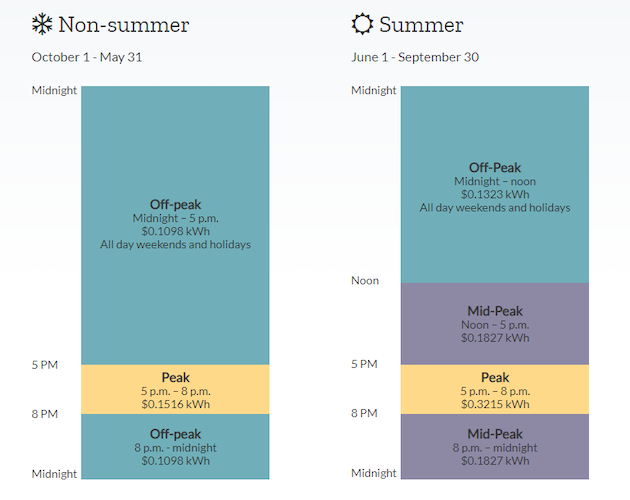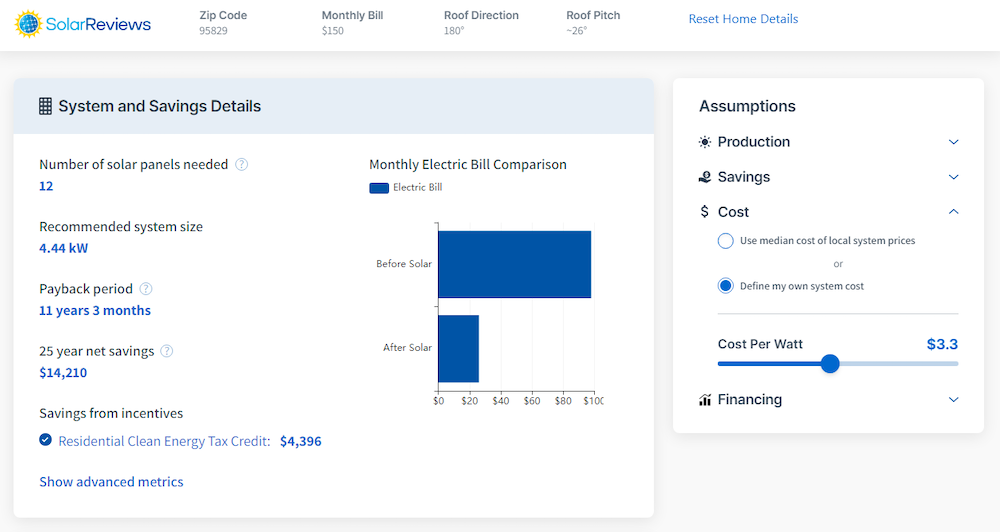Updated 1 year ago
Going solar with SMUD: what you need to know
Written by
Ben Zientara

Find out what solar panels cost in your area
For over 75 years, residents in most of Sacramento county have enjoyed the privilege of being served by the Sacramento Municipal Utility District, aka SMUD; a community-owned non-profit electric utility carved out from Pacific Gas & Electric territory in 1946.
SMUD’s electric service territory is like an island in the PG&E ocean, but the residents here haven’t brought Lord of the Flies to the Sac Valley. Instead, SMUD customers enjoy some of the lowest electricity prices in California, which makes living here just a little nicer. That said, everyone would love to eliminate their electric bill, right?
Unfortunately, when it comes to solar power, those lower energy prices mean it takes a little longer for a SMUD customer to see the full payback of the costs of their solar system. And in March of 2022, SMUD introduced a new rate for those customers called the Solar and Storage Rate (SSR), which eliminated net metering and reduced payments made to solar owners for extra energy their systems send back to the grid.
Let’s dive into how the SSR works and how people in Sacramento can maximize their savings with solar!
Going solar with SMUD at a glance:
-
SMUD Customers who install solar panels must sign up for the Solar and Storage Rate, or SSR, which is a modified version of the existing Time of Day rate.
-
The SSR shares the Time of Day rate’s increased pricing during peak times and establishes a rate of 7.4 cents per kWh that SMUD pays customers for excess solar electricity they don’t use in their home.
-
Depending on the time of day, 7.4 cents is roughly 33% to 77% less than the retail price customers pay for electricity from SMUD.
-
The reduced credit for excess solar energy means it takes a little longer for homeowners to see a financial benefit from their solar panels compared to people served by PG&E.
-
At the right price, a solar installation can be a good financial investment for a SMUD customer, with payback times of 10-15 years for a system that should last 25 years.
SMUD rate plans and rules
Knowing your current rate plan and bill can help you determine if solar is a good deal for you. Look at what you’re paying now, and compare the possible savings we describe below.
SMUD customers without solar choose between two rate plans: Fixed Rate or Time of Day. Both plans start with the same $23.05 monthly fixed charge, then add usage charges for every kilowatt-hour (kWh) of electricity a customer draws from the grid.
The Fixed Rate plan is the simplest, offering a flat rate for each kWh that varies from a high of about 19 cents in the summer (June 1 to September 30), to a low of about 11.5 cents for the rest of the year. This makes it easy to know what your bill is going to be—it’s just kWh of usage multiplied by the rate that month.
But SMUD’s cost to purchase electricity from wholesale suppliers varies by the time of day. Most customer demand comes in the evening, and it costs SMUD lots of money to add extra power to the grid on evenings when demand is very high, because supplies are limited.
That’s why SMUD offers the Time of Day plan. It can help people save money if they shift electricity usage to off-peak times. If you decide to install solar panels, you’ll switch to a special version of the Time of Day rate called the Solar and Storage Rate (SSR). Here’s how the SSR works:
SMUD’s Solar and Storage Rate
The Solar and Storage Rate is the required rate plan for people who get solar panels installed (or add more panels or a battery to an existing system) after March 2022. The SSR uses the same rates as SMUD’s Time of Day rate plan, with different electricity prices based on the time of day the energy is being used. The plan also includes a monthly fixed charge of $23.05.
Like other Time of Use rate plans, this plan is designed so that electricity is more expensive during the parts of the day when it’s most in demand. The rates also vary by season; higher in the summer, and lower the rest of the year.
Here’s a look at the various rates and times of day involved:

Rates change from a low of around $0.11/kWh for most times and days in the fall, winter, and spring, to a high of over $0.32/kWh on summer evenings. Customers save a good deal of money by not using big appliances during these peak times. Image source: SMUD
If you install solar panels, the energy they produce is used to power things in your home, reducing the amount of energy you need to buy from SMUD and saving you whatever the kWh rate is at the time. For example, let’s say your solar panels make 20 kWh on a summer day. Here’s how the savings might break down using the Time of Day rates from above:
Time | Solar energy produced | Electric rate | Money saved |
|---|---|---|---|
9 AM - 12 PM | 5 kWh | $0.1323/kWh | $0.6615 |
12 PM - 5 PM | 10 kWh | $0.1827/kWh | $1.827 |
5 PM - 8 PM | 5 kWh | $0.3215/kWh | $1.6075 |
Total saved | $4.096 | ||
You’d save about $4.10 that day if all 20 kWh went to powering your home. Average that out to a month, and it’s $123 in savings. Not too shabby!
But what happens if your solar panels make more electricity than you can use at the time?
Can you sell electricity to SMUD?
If your solar panels make electricity you don’t need right away, it gets sent to your neighbors by way of the wires outside your house. Under SMUD’s Solar and Storage Rate, that electricity is purchased by the utility for $0.074/kWh, no matter what time it is produced.
At the end of the month, SMUD adds up all the kWh you sent them, multiples that by $0.074/kWh, and applies the total as a credit on your bill. The credit offsets the amount you owe for the energy you purchased from the grid when your solar panels weren’t making power, like at night. This credit cannot offset the $23.05 fixed charge, but if you earn a credit that’s larger than what you owe for usage charges, the remainder carries over to the next month.
Can a battery save you more money? Home solar batteries are becoming very popular in California because they protect against power outages and help owners avoid high charges for peak electricity. You can charge a battery with solar energy all day instead of selling it to SMUD and use it to meet all your home’s needs from 5 to 8 PM, eliminating all that expensive usage. Unfortunately, batteries add a great deal of expense to a solar system. But for those who want the benefits they can provide, there are incentives to help reduce the cost!
Solar incentives for Sacramento homeowners
The most important incentive for any solar or battery storage system is the federal clean energy tax credit. Re-authorized and expanded in the Inflation Reduction Act of 2022, this tax credit provides up to 30% of the costs to install solar panels and/or batteries back to the homeowner at tax time during the year after final installation. If you have taxable income, this is a great way to save a lot of money on installing clean energy appliances.
SMUD itself offers a battery incentive program called “My Energy Optimizer.” It offers three levels of incentives depending on the type of battery you have and how much control you give SMUD to use the battery during peak events when demand for power is exceptionally high. The incentives can earn battery owners between $50 and $250 for every kWh of storage—for example, that’s a payment of between $500 and $2,500 that can reduce the cost of a Tesla Powerwall installation.
SMUD customers are also eligible for California’s Self-Generation Incentive Program (SGIP). This program offers reimbursement of costs paid for an energy storage system, based on the size of the battery in watt-hours. The current incentive amount can be found on the program website, but at the time of writing, it was $0.15/Wh—equal to $2,025 for a Powerwall.
Unrelated to solar, but SMUD also offers a special EV charging rate. If you charge your electric vehicle between midnight and 6 am, you save 1.5 cents per kWh more than the already low off-peak rate.
All these incentives combined can really make a difference in the price to go solar.
How to go solar in SMUD territory
The next step on your solar journey is to estimate the size of the solar system you need for your house, then get quotes from installers and compare them. SMUD allows homeowners to install a solar system that will produce up to 100% of their previous 12 months’ electricity usage.
The easiest way to get an estimate of the number of solar panels your home needs is to use the SolarReviews Solar Panel Calculator. By entering just your ZIP code, monthly bill, and roof direction, you can get a quick estimate of the number of panels you’ll need and how much energy they’ll produce, as well as cost, incentives, and potential financial savings. The calculator uses actual rate structures based on SMUD’s Time of Day rate, solar production numbers from PVwatts, and our own database of incentive information.
Here’s how it looks for a home in the 95829 ZIP code with an average monthly bill of $150:

Once you’ve seen the initial estimates, you can scroll down to find local solar installers and compare prices tailored to your home and needs. You can also use the calculator to go back and check your installer’s assumptions, as we discuss in this video:
You can also use SolarReviews to read reviews of solar installers you’re considering and see what their past customers say about them!
Other solar programs for SMUD customers
Don’t have the perfect room for solar panels? SMUD offers a couple of other programs that can help people take advantage of solar—especially people with low incomes living in multifamily housing. These programs are Community Solar, Virtual Solar, and Neighborhood SolarShares.
Here’s a little bit about how each program works.
Community solar allows nonprofit organizations and people whose houses were built by Habitat for Humanity to get a free rooftop solar system on their property. The systems help reduce energy bills for the people living and working in the building. This program is supported by a very small monthly charge on the bills of all SMUD customers.
Virtual solar allows owners of multifamily buildings with at least 4 units to install solar energy systems that benefit both the tenants and owner. A certain percentage of the power generated by the system is allocated to each tenant and can also be allocated to the common area. At least 51% of the system must be allocated to the tenants in the building. A credit of $6 per kilowatt (kW) per month is paid to participants in non-summer months, with the credit increasing to $16 per kW in the summer. These credits directly offset the utility bills for each tenant and the building owner.
Neighborhood SolarShares is a program for which SMUD partnered with a solar developer to complete a large-scale solar installation that provides power to the grid. The energy produced is allocated to new-construction homes and apartments in SMUD territory to allow builders to comply with the California Energy Commission’s rules requiring all new homes to offset energy usage with solar. Obtaining solar energy from the SolarShares project means the builders don’t have to install solar panels on the rooftops of new homes where it wouldn’t make sense.
Bottom line: does solar make sense in SMUD territory?
Here’s where we get down to the real question. Is it a good idea to install solar panels on your Sacramento home? As you might imagine, the answer is more complicated than a simple yes or no.
It boils down to this: if your home has a suitable, south or east/west facing roof with relatively new shingles/tiles that doesn’t get any shade throughout the day, and if you can get a good price on a solar installation from a local installer, solar can make good financial sense in SMUD.
The payback time in our example above was just over 11 years, while solar panel installations come with warranties that guarantee they’ll be putting out power for 25 years or more. With SMUD raising rates by an average of 3% for the last several years, the savings from solar will keep growing. Add to that a small increase in home value from having solar panels, and you can rest assured that you’re making a sound investment.
But, if your roof isn’t ideal, or you evaluate the solar quotes you get and find they’re not up to snuff, going solar is possibly not right for you. As we said in the beginning, SMUD has lower rates than PG&E, while at the same time it recently reduced the amount it pays for excess solar energy for people who purchase a new solar system.
If you’re ready to begin the process of looking for a solar installer, explore our solar calculator, click through to find local pricing from installers in Sacramento, and discover that solar is right for you!
Ben Zientara is a writer, researcher, and solar policy analyst who has written about the residential solar industry, the electric grid, and state utility policy since 2013. His early work included leading the team that produced the annual State Solar Power Rankings Report for the Solar Power Rocks website from 2015 to 2020. The rankings were utilized and referenced by a diverse mix of policymakers, advocacy groups, and media including The Center...
Learn more about Ben Zientara